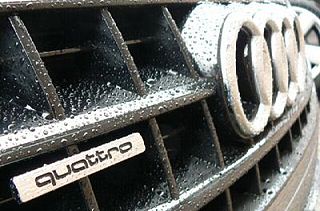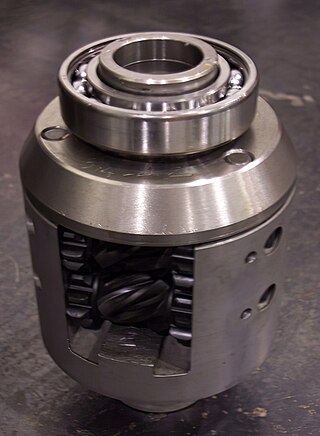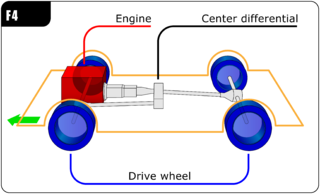Related Research Articles

Four-wheel drive, also called 4×4 or 4WD, refers to a two-axled vehicle drivetrain capable of providing torque to all of its wheels simultaneously. It may be full-time or on-demand, and is typically linked via a transfer case providing an additional output drive shaft and, in many instances, additional gear ranges.

The Ford Explorer is a range of SUVs manufactured by Ford Motor Company since the 1991 model year. As the first four-door SUV produced by Ford, the Explorer was introduced as a replacement for the two-door Bronco II. Within the current Ford SUV range in North America, the Explorer is slotted between the Ford Edge and Ford Expedition. As with the Ford Ranger, the Explorer derives its name from a trim package previously offered on the Ford F-Series pickup trucks.

The Renault Kangoo is a family of vans built by Renault since 1997 across three generations. It is sold as a passenger multi-purpose vehicle or as a light commercial vehicle. For the European market, the Kangoo is manufactured at the MCA plant in Maubeuge, France.

The Mazda MPV is a minivan manufactured by Mazda. Introduced in 1988 as a rear-wheel-drive model with optional selectable four-wheel drive, this was replaced in 1999 with a front-wheel-drive version with optional all-wheel-drive in some markets. Over one million MPV models have been produced since its introduction.

Quattro is the trademark used by the automotive brand Audi to indicate that all-wheel drive (AWD) technologies or systems are used on specific models of its automobiles.

The Mazda Bongo, also known as Mazda E-Series and the Ford Econovan, is a cabover van and pickup truck manufactured by the Japanese automobile manufacturer Mazda since 1966. The Bongo name was also used for the Bongo Friendee, which is not a cabover design.

The Ford Escape is a compact crossover SUV sold by Ford since the 2001 model year. The first Ford SUV derived from a car platform, the Escape was slotted below the Ford Explorer in size; the Escape is currently sized between the Ford EcoSport and Ford Edge. In another first, the 2004 Ford Escape Hybrid was the first hybrid-electric vehicle from Ford, and the first hybrid produced as an SUV.

The B platform is an automobile platform for compact and subcompact cars of the Renault-Nissan Alliance since 2002.

The Nissan Tiida is a compact car produced by the Japanese manufacturer Nissan from 2004 to 2023 through three generations. Depending on the market, the Tiida was also marketed as a subcompact car, particularly in the Americas for the first-generation model as the Nissan Versa. The first-generation model (C11) was produced up to 2018 in some markets, and was offered as a four-door sedan and a five-door hatchback.
Hybrid Synergy Drive (HSD), also known as Toyota Hybrid System II, is the brand name of Toyota Motor Corporation for the hybrid car drive train technology used in vehicles with the Toyota and Lexus marques. First introduced on the Prius, the technology is an option on several other Toyota and Lexus vehicles and has been adapted for the electric drive system of the hydrogen-powered Mirai, and for a plug-in hybrid version of the Prius. Previously, Toyota also licensed its HSD technology to Nissan for use in its Nissan Altima Hybrid. Its parts supplier Aisin Seiki Co. offers similar hybrid transmissions to other car companies.

The Nissan AD is a subcompact van and wagon built by Nissan since 1982. The AD is sold under a different name when manufactured as a passenger car, called the Nissan Wingroad.

Torsen Torque-Sensing is a type of limited-slip differential used in automobiles.

The Nissan Cube is a mini MPV produced by carmaker Nissan between 1998 and 2019. Initially sold only in Japan, the Cube was sold in North American markets from 2009 to 2014, and in European markets from 2009 to 2011. In Japan, it was exclusive to Nissan Red Stage dealerships. It is a slightly larger load-carrying alternative to the Nissan Micra hatchback. While production for the North American market ended in 2014, the Japanese-market Cube lasted until December 2019.

The Nissan X-Trail is a compact crossover SUV produced by the Japanese automaker Nissan since 2000. Since its introduction, the X-Trail is positioned below the truck-based Xterra and Pathfinder.
ATTESA is a four-wheel drive system used in some automobiles produced by the Japanese automaker Nissan, including some models under its luxury marque Infiniti.
Hybrid vehicle drivetrains transmit power to the driving wheels for hybrid vehicles. A hybrid vehicle has multiple forms of motive power.

The Nissan Sylphy is a compact car produced by the Japanese car maker Nissan since 2000 as the successor to the Nissan Pulsar. The Sylphy has also been marketed in export markets under several other nameplates, including Pulsar, Almera, Sunny and Sentra. For the third-generation model (B17) introduced in 2012, the Sylphy model was merged with the B17 Sentra, meaning it is no longer a standalone model.

In automotive design, an F4, or front-engine, four-wheel drive (4WD) layout places the internal combustion engine at the front of the vehicle and drives all four roadwheels. This layout is typically chosen for better control on many surfaces, and is an important part of rally racing, as well as off-road driving. In terms of racing purposes, whether it be on-road or off-road, can be described as follows,
A team that pursues the Weak LS4WD architecture will minimize the development cost of the front-wheel drive system at the expense of having a larger rear powertrain. The Weak architecture produces a vehicle with a large powersplit between the front and rear powertrains, while the Strong architecture recommends a vehicle with more similar power and torque requirements for the front and rear.
All Wheel Control (AWC) is the brand name of a four-wheel drive (4WD) system developed by Mitsubishi Motors. The system was first incorporated in the 2001 Lancer Evolution VII. Subsequent developments have led to S-AWC (Super All Wheel Control), developed specifically for the new 2007 Lancer Evolution. The system is referred by the company as its unique 4-wheel drive technology umbrella, cultivated through its motor sports activities and long history in rallying spanning almost half a century.

The Mazda2 is a subcompact/supermini (B-segment) car manufactured and marketed by Mazda since 2002, currently in its third generation. An entry-level model of the brand in markets outside Japan, the Mazda2 is positioned below the Mazda3. The Mazda2 has also been marketed as the Mazda Demio, while its direct predecessor was exported as the Mazda 121.
References
- ↑ "E-4WD System" (PDF). Nissan. Archived from the original (PDF) on 17 September 2012. Retrieved 30 April 2013.
- ↑ "Hitachi Electric 4WD System" (PDF). Hitachi. Retrieved 5 December 2013.